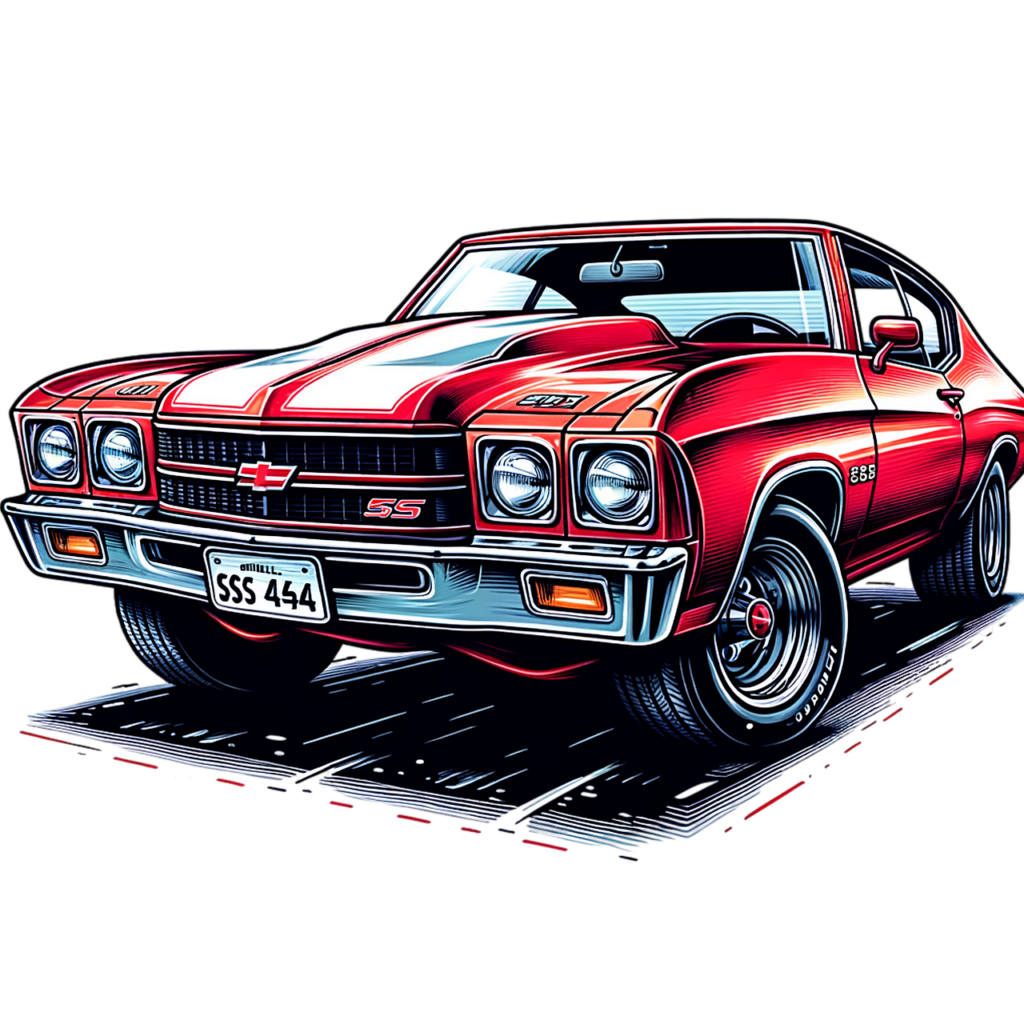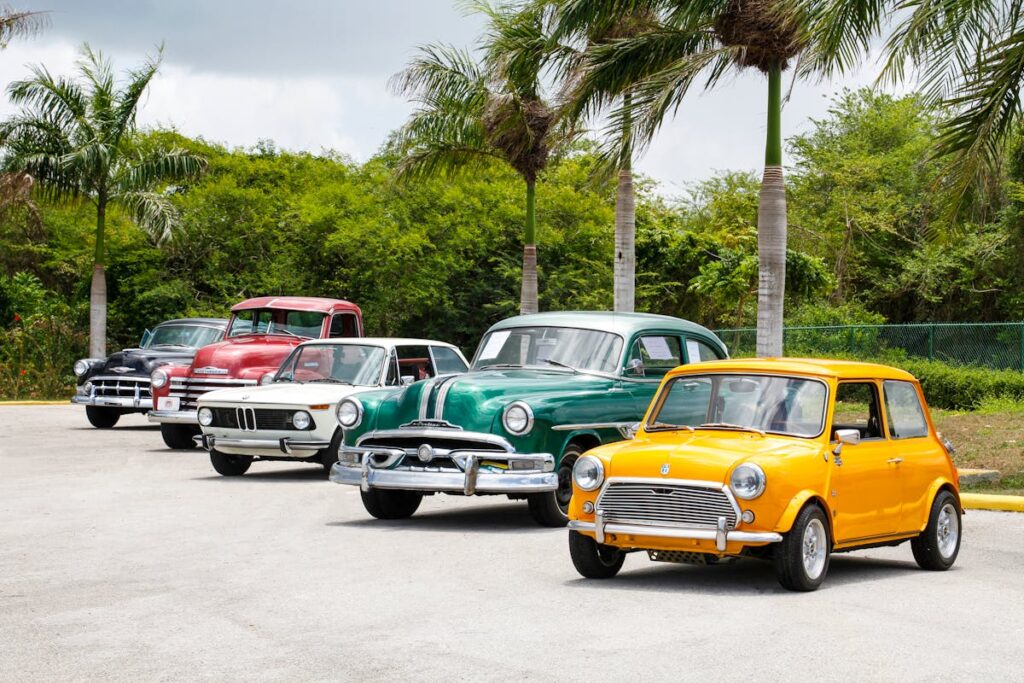American classic cars, from the polished chrome accents to the rumble of a powerful V8 engine, evoke a sense of nostalgia and reveal a rich tapestry of the nation’s industrial history. These automobiles, often seen as embodiments of the American Dream, have left an indelible mark on our collective psyche. They are not merely vehicles, but symbols of innovation, freedom, and cultural identity. The question then arises: what is it about these mechanical marvels that continue to captivate our imagination, and how have they retained their allure in the face of modern, more technologically advanced vehicles?
Key Takeaways
- American Classic Cars represent the Golden Age of automobiles, characterized by innovation, powerful engines, and artistic designs.
- Iconic manufacturers include Ford, General Motors, and Chrysler, whose designs influenced global automotive trends and collaborations.
- Muscle cars, born in the 1960s, are iconic American classics, known for their powerful engines and aggressive aesthetics.
- Classic cars have a significant cultural impact, featuring in films, music, and television, and symbolizing freedom and rebellion.
- Investing in vintage American cars can offer long-term value, but requires knowledge of the market and restoration costs.
The Golden Age of Automobiles
Often considered a landmark period in automotive history, the Golden Age of Automobiles is a treasured era that greatly shaped the American classic car landscape. Spanning the 1950s to the early 1970s, it was an epoch marked by exceptional innovation and artistry, the blend of which birthed an array of iconic vehicles.
The era’s vintage aesthetics were characterized by sweeping lines, ample chrome detailing, and bold colors, creating an irresistible allure that still resonates today. The design of the cars was a reflection of the optimism and prosperity of post-war America, with automotive manufacturers endeavoring to encapsulate these sentiments in their products. The resulting vehicles, revered for their beauty and craftsmanship, embody a tangible sense of automotive nostalgia.
Beyond the aesthetics, functionality was also prioritized. Advances in technology allowed for the development of powerful engines, improved suspension systems, and enhanced safety features. These advancements, coupled with the stunning aesthetics, created an enduring legacy that continues to captivate car enthusiasts.
The Golden Age of Automobiles was not merely a period of mechanical evolution, but rather a profound reflection of the intersection of artistry, innovation, and culture in automotive design. This era remains an indelible part of American heritage, forever encapsulated in the timeless beauty of its classic cars.
Iconic American Car Manufacturers
In the rich tapestry of American automobile history, a handful of manufacturers stand out for their innovation, influence, and iconic status. These pioneering companies not only shaped the automotive landscape domestically, but their influence reverberated globally, changing the way vehicles are designed, manufactured, and perceived. This discussion will highlight these trailblazers, their contributions to the global automotive industry, and the significant innovations they introduced that revolutionized the world of cars.
Pioneering American Car Companies
Throughout the annals of automotive history, several American car companies have greatly shaped the industry, cementing their status as pioneers. Many of these companies, including Ford, General Motors, and Chrysler, were pre-war pioneers who made considerable strides in automotive design during the early 20th century.
Ford, established by Henry Ford in 1903, was renowned for its innovative assembly line production method, which revolutionized the manufacturing process and considerably reduced the cost of automobiles. Their Model T, introduced in 1908, was a proof of this revolutionary approach, making cars more accessible to the average American citizen.
General Motors, founded in 1908, was a conglomerate of several smaller car companies. GM was instrumental in the development of automotive design, pushing for advancements in aesthetics, performance, and safety. This commitment to design excellence is evident in classic models such as the Chevrolet Suburban and the Cadillac DeVille.
Chrysler, founded in 1925, also contributed to the evolution of automotive design, through their emphasis on aerodynamics and power. Their Airflow model, introduced in the 1930s, was a pioneer in streamlined design.
These companies set the groundwork for the modern automotive industry, reflecting the pioneering spirit of American innovation.
Influence on Global Automotive
The pioneering spirit of American car manufacturers did not just shape the domestic market but also left an indelible mark on the global automotive industry. American companies’ influence on global design trends has been significant, with their automotive styling influence permeating international collaborations and shaping automotive design evolution.
Prominent American brands have led the way in forging partnerships with overseas manufacturers, fostering a rich cultural exchange impact. These collaborations have not only expanded the reach of American automotive design but have also enriched it, absorbing and integrating elements from international design philosophies.
The global racing heritage of American classic cars is another indication of their influence. From the Indianapolis 500 to Le Mans, American muscle and sports cars have left an indelible mark, influencing design and performance trends worldwide.
The vintage market’s growth is largely attributed to classic car events showcasing American masterpieces, further cementing the country’s influence on global automotive culture. These events, held around the world, celebrate the genius of American design, engineering, and manufacturing, and are pivotal in promoting the appreciation and preservation of American classic cars. This enduring global impact reflects the pioneering approach of American car manufacturers, driving the global automotive industry forward.
Noteworthy American Automotive Innovations
With a rich legacy of innovation, American automakers have pioneered significant advancements that have revolutionized the automotive industry. They have consistently pushed boundaries, creating vehicles that are not only efficient and reliable, but also aesthetically pleasing.
A key innovation is the development and refinement of electric vehicle advancements. American manufacturers have made remarkable strides in this area, with companies such as Tesla leading the charge. They have harnessed cutting-edge technology to produce electric cars with extended range and performance that rivals conventional vehicles. This breakthrough has not only transformed the automotive landscape, but also paved the way for a more sustainable future.
Furthermore, American automakers have championed automotive safety innovations. In the 1950s, for instance, they introduced seat belts, which have since saved countless lives. More recently, they have incorporated advanced safety features such as automatic emergency braking, adaptive cruise control, and lane-keeping assist into their vehicles. These innovations have made driving safer and more comfortable, underscoring the industry’s commitment to enhancing consumer experience.
These significant American automotive innovations are evidence of the creativity and ingenuity of American automakers, and they continue to set the pace for the global automotive industry.

The Birth of Muscle Cars
The genesis of muscle cars in the United States marked a significant shift in automotive design and performance during the mid-20th century. These vehicles, exemplified by iconic models such as the Ford Mustang and Chevrolet Camaro, were characterized by their powerful engines and sleek, aggressive aesthetics. In addition, the cultural impact of muscle cars cannot be understated, as they became symbols of American innovation, freedom, and raw power, deeply influencing popular culture and the global automotive industry. To learn more about these legendary vehicles and the era they represent, you can discover the golden age of American muscle cars and explore the top classic car models and brands that continue to shape automotive history.
Genesis of Muscle Cars
In the heart of America’s automotive industry during the early 1960s, a new breed of powerful vehicles roared to life, forever changing the landscape of car culture. These muscle cars, a hallmark of American horsepower, were born out of a potent mix of market trends and consumer preferences.
The genesis of muscle cars was deeply rooted in engine performance and racing heritage. Manufacturers began to incorporate powerful V8 engines into smaller, lighter frames, creating a design evolution that catapulted these vehicles into the spotlight. The market trends of the time were veering towards speed and power, and the industry responded in kind.
Consumer preferences played a seminal role in shaping the muscle car era. The nostalgia factor was immense, with many consumers harking back to the golden age of American motor racing. Additionally, the customization options available for these vehicles were unprecedented, allowing car enthusiasts to personalize their rides down to the smallest detail.
These vehicles also became iconic soundtracks of their time, their unmistakable roars echoing through the streets, instantly recognizable to car club members and enthusiasts alike. The genesis of muscle cars, fundamentally, marked a pivotal moment in American automotive history.
Iconic Muscle Car Models
Having explored the genesis of muscle cars, it becomes clear that this automotive revolution gave way to the creation of some iconic models that enthralled car enthusiasts worldwide. The emergence of these vehicles was a demonstration of the American car industry’s innovation and resilience, as manufacturers sought to balance aesthetics, engine performance, and affordability.
The design evolution of muscle cars is a fascinating journey into the heart of American car culture. The 1964 Pontiac GTO is often credited as the first true muscle car. Its high-performance engine, an optional 389 cubic inch V8, set a standard that would be emulated by others. Ford’s Mustang, which debuted the same year, offered consumers a smaller, nimbler option with various engine choices that still met the performance criteria.
Similarly, the Chevrolet Camaro and the Dodge Charger, both introduced in the late 60s, offered powerful engines and aggressive styling, further establishing the muscle car’s place in the automotive landscape. These models weren’t simply vehicles, they were symbols of freedom and power, embodying the spirit of their era. It is this perfect storm of engine performance and design evolution that solidified their iconic status.
Muscle Cars’ Cultural Impact
Undeniably, the advent of muscle cars left an indelible mark on American culture, one that transcends beyond the domain of automobile enthusiasts. This cultural impact can be attributed to the unique muscle car aesthetics and the vibrant muscle car communities that emerged across the country.
The muscle car aesthetics, characterized by sleek lines, powerful engines, and bold colors, captured the spirit of freedom, rebellion, and raw power. They became symbols of the post-war American optimism, projecting an image of speed, power, and masculinity. This aesthetic appeal was not limited to the cars themselves but seeped into popular culture, influencing fashion, music, and cinema, and shaping the identity of an entire generation.
Equally significant is the role of muscle car communities that nurtured and amplified this cultural impact. These communities, fostered by shared passion and camaraderie, acted as a catalyst for broader societal conversations around speed, design, and the open road. They transformed the muscle car from a mere transportation tool into a cultural icon, reflecting the collective aspirations and attitudes of the time. This profound cultural impact of muscle cars continues to resonate in the American psyche, underlining their status as American Classic Cars.
Classic Cars in Popular Culture
Few phenomena have captivated the collective imagination quite like classic cars in popular culture. Their film representations have been pivotal in creating iconic moments in cinema such as the 1968 Ford Mustang GT from “Bullitt” or the DeLorean from “Back to the Future”. Music references, such as Prince’s “Little Red Corvette”, have immortalized classic cars in lyrics.
Television portrayals have also played a significant role. Shows like “Knight Rider” and “Dukes of Hazzard” transformed vehicles into characters, sparking the imagination of audiences. Classic cars have further gained prominence through advertising campaigns and celebrity ownership, adding to their appeal and status.
The racing heritage of classic cars is another vital aspect of their cultural significance. Brands like Ford, Chevrolet, and Dodge are remembered for their contribution to the racing industry, increasing the nostalgia factor associated with these vehicles. Car clubs, restoration shows, and automotive exhibitions have furthered the interest in classic cars, providing platforms for enthusiasts to share knowledge, showcase restorations, and celebrate the history of these vehicles.
A classic car’s allure extends beyond its aesthetic or performance; it represents a period in history, a piece of art, and a symbol of personal expression and freedom.
The Art of Car Restoration
While the cultural significance and nostalgia associated with classic cars are undeniable, an integral part of their charm lies within meticulous restoration processes. These processes are often complex, involving numerous restoration techniques and a deep understanding of automotive history and design.
Restoration techniques vary widely, from basic mechanical work to detailed reconstruction of the car’s original features. Often, experts will start by inspecting and repairing the car’s structural integrity, focusing on the chassis and bodywork. They then move on to the engine and other mechanical systems, ensuring they are in working order.
Car preservation is another essential aspect of the restoration process. This involves protecting the vehicle from potential damage, both internally and externally. Techniques used include rust prevention, paint protection, and careful storage to maintain the car’s condition over time.
The art of car restoration is not merely about fixing old cars. It’s about respecting and preserving the history of these automotive gems, ensuring they continue to provide joy and nostalgia for future generations. For those interested in learning more about the restoration process, a great resource is A beginner’s guide to restoring classic American cars, which offers a comprehensive look into the world of classic car restoration, including step-by-step techniques and tips. The meticulous work involved in these restoration processes truly brings these classic American cars back to life, highlighting their historical and cultural importance.
Investing in Vintage American Cars
The allure of vintage American cars extends far beyond their aesthetic appeal or historical significance. For many, these timeless machines represent a fruitful investment opportunity. This arises not merely from vintage car appreciation, but also from careful investment strategies and understanding market trends.
Classic car auctions have become a hotbed for investors seeking long-term value. However, investing in these automotive relics is not without its challenges. Restoration challenges and high maintenance costs can erode returns, making it essential for investors to factor these into their cost-benefit analysis. Insurance considerations also play an essential role, with the need to protect these valuable assets from unforeseen damages.
Ownership benefits surpass the financial sphere, extending to social prestige and entry into exclusive collector communities. These communities often provide valuable insights into market trends and offer a support network for restoration and maintenance challenges.
However, investing in vintage American cars requires careful planning, a deep knowledge of the market, and patience. The returns are not immediate but can be substantial over time. It is an investment that demands passion as much as it does financial commitment, making it an exciting venture for car enthusiasts and investors alike.
Most Valuable Classic American Cars
In the domain of classic American cars, there’s a myriad of models that hold substantial monetary value, each imbued with its unique history and craftsmanship. Many of these vehicles have been showcased in classic car auctions and vintage car shows, enthusiastically sought after by enthusiasts who appreciate their rarity and design.
Such rare car collections often require significant investment, not just in the initial purchase but also in maintenance and classic car insurance. It’s not uncommon for owners to spend thousands on car restoration techniques to preserve or enhance their vehicle’s condition. Vintage car financing can assist in this pursuit, making these classics more accessible to a wider audience.
These high-value classics are also an integral part of classic car rallies, where they’re admired for their exquisite automotive design trends reflective of bygone eras. The value of these vehicles is not just in their monetary worth, but in the cultural and historical significance they carry, encapsulating the spirit of American automotive innovation in their steel frames and polished chrome.
Owning one of these valuable classic cars is not just a financial investment, but a commitment to preserving a piece of American history.
Frequently Asked Questions
What Are Some Common Challenges in Maintaining American Classic Cars?
Common challenges in vintage vehicle maintenance include high restoration costs due to the need for specialized skills and the difficulty of sourcing rare or out-of-production parts, which can often be expensive or unavailable.
Are There Clubs or Communities Dedicated to American Classic Car Enthusiasts?
Yes, various clubs and communities exist that cater to enthusiasts. These organizations typically offer club membership, hold community events, and provide platforms to share knowledge and resources related to classic car maintenance and restoration.
How Does the Fuel Efficiency of Classic American Cars Compare to Modern Vehicles?
Compared to modern vehicles, classic cars generally have lower fuel efficiency due to older engine designs and lack of advanced fuel technology. However, engine modifications can potentially enhance their fuel performance to some extent.
What Is the Environmental Impact of Owning and Driving a Classic American Car?
The environmental impact of owning and operating vintage vehicles can be significant due to less stringent emission regulations during their production years and potential harmful restoration practices. However, regular maintenance can mitigate some impact.
Are There Modern Safety Features That Can Be Installed in Classic American Cars?
Yes, numerous modern safety upgrades can be installed to enhance protection. Retrofitting options include seat belts, antilock brakes, traction control systems, and airbags, which can greatly increase the safety level of these vehicles.

